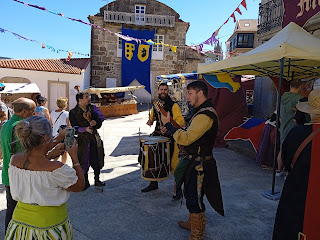As I mentioned, this year I didn't experience any new Entroido traditions, but I couldn't just stay at home for five days in a row. So we took an express trip east to neighboring O Bierzo. Centuries ago, when Galicia was a kingdom (O Reino de Galiza), the region of O Bierzo was considered part of it. Nowadays, it's technically part of Castilla y León, even though there are some sections where they speak Galician.
 |
| Pretty start |
First stop: Corullón, a small village with specific hiking trails around their cherries. Since during the week before Entroido plenty of trees had been in bloom around town, I was hopeful. Cherry blossoms! Unfortunately, we are destined to not see cherry blossoms by the millions. This is
the second time I have jumped the gun in terms of the spring visual treat. In the neat rows of around one hundred cherry trees, only ONE was blossoming. Thank you, early bloomer! I insisted I would go back later on this year, when cherry blossom season is in full swing. But now-- especially with the price of gas soaring-- I think it will once again have to wait til next year. We did spot a Romanesque church, however, so not all was lost in Corullón.
 |
| San Nicolás |
Next stop: Villafranca del Bierzo. More of a town than a village, this was our home base for the night. At lunchtime it was sunny so first we got a drink in the main plaza which had a good amount of people. We sat at a
terraza that seemed to be for the fashionable old ladies to socialize before going home to lunch. And here they also gave a hot tapa, garlic soup. For lunch we ate in a bar/restaurant decorated with dark wooden beams on the ceiling and a fire burning in the corner. Now that's what we call
enxebre! But here's how you can tell O Bierzo is no longer in Galicia: when they serve a ¨spoon dish¨ such as soup or lentils, they don't leave the entire pot. This would be considered a crime in Galicia! I've heard of families who never return to a restaurant not because of poor service, high prices, or bad food, but because they didn't leave the stew pot for them to help themselves to seconds. It seemed weird to me that the waitress even brought the small serving pot of soup out. If she wasn't going to leave it, why not just bring out a bowl filled with soup? But I digress 😉
After that grave offense at lunch, we decided to get the coffee on the road. After a copious meal, we almost always stay to have a coffee and a shot of digestive liqueur. I myself don't usually partake in this tradition. On this occasion, getting our after-lunch drinks somewhere else encouraged us to walk around the rest of the town. Originally we had planned to explore in the late afternoon before dinner, but we saw just about everything in the hour after lunch. Aside from the aforementioned plaza, in Villafranca there is also a tree-lined avenue that seems to be the other area to get a drink on a terraza. For some reason, it was easy to imagine the town bustling in summer months. But at the end of February and on a Monday, it was pretty much dead.
As far as sightseeing goes, Villafranca has two churches. It's on the camino to Santiago, and one of its churches is also called Santiago. It was a valid stopping point in case of injury. If someone had been walking for a spiritual debt, but got injured on the way, they could go to the puerta del perdón (door of forgiveness) in Villafranca del Bierzo and it would be considered forgiven. Then there's San Nicolás, an imposing building which has had a variety of uses including school, city hall, and church. There is also a round castle, but it's private so you can only observe it from afar. In general the town has lots of old architecture, and in some cases dilapidated. One cobblestone street is house after house with coats of arms, clearly the old wealthy road.
 |
| Coat of Arms, Calle del Agua |
 |
| The ¨Royal Road¨ |
The following morning, we continued east, past Ponferrada, just to see the town of Molinaseca. The place is listed as one of Spain's Most Beautiful Villages. The moniker and village did not disappoint. Despite the rain and near-emptiness of streets, it was still an absolutely lovely town for a quick stroll. I'm adding it to my own personal list of places that remind me that I'm in Europe. That would be due to the cobblestone streets and dark beams on buildings. Flashback to the Middle Ages! It seemed more well-kempt than Villafranca del Bierzo. You could tell they lived off tourism and the Camino de Santiago. Leading out of the village is a Roman bridge, and on the outskirts is Shrine to the Our Lady of Sorrows. The doors are coated in metal sheets because apparently all the pilgrims used to want to take a splinter from the door. The view from this church was the trip's grand finale-- a blooming tree framing the village's other church in the background. Finally, some blossoms in O Bierzo!











.jpg)






.jpg)

.jpg)









